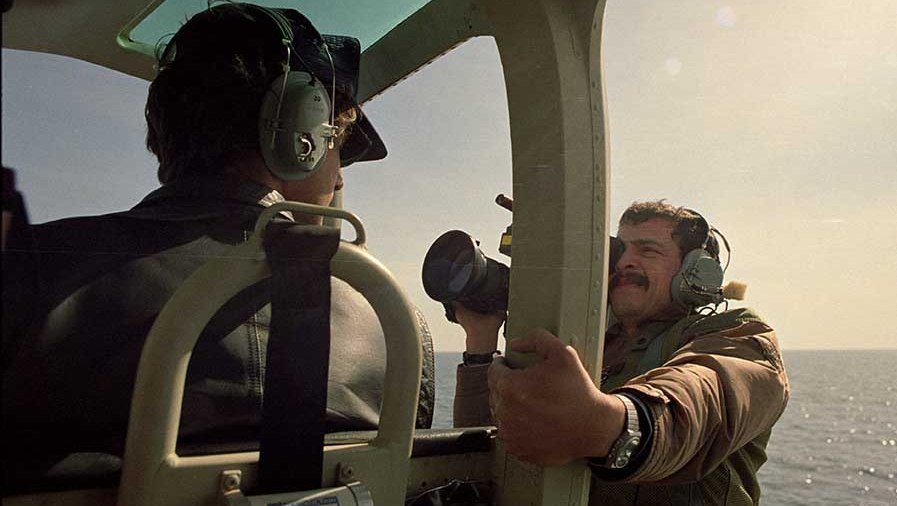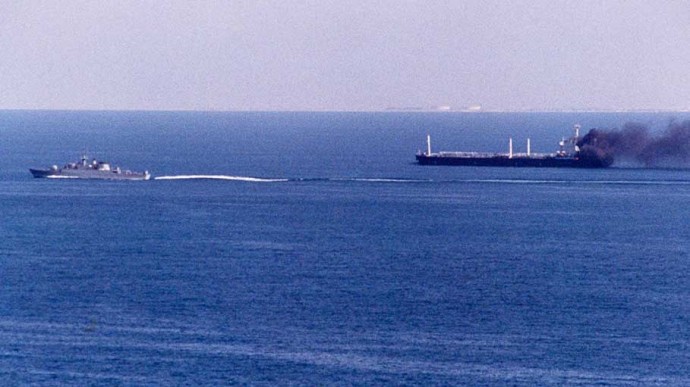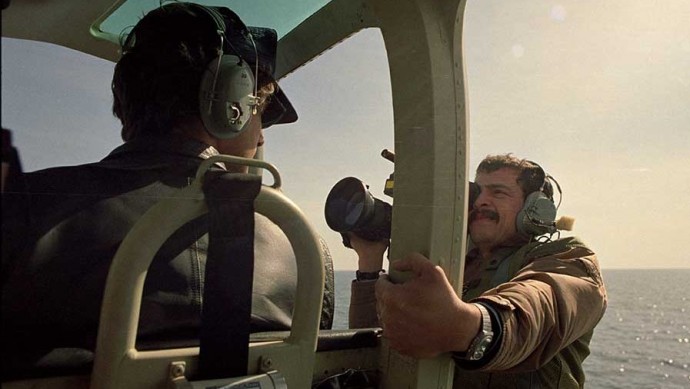
In my third installment, I mentioned that during the daylight hours we were on call in case of an Iranian attack or passing U.S. Navy convoy, and we were basically confined to the Hyatt Regency complex. Luckily, the CNN bureau chief was obsessed with monitoring radio traffic alone and didn’t mind if we were not in the office. This allowed us to wander around the Hyatt complex or spent time at the pool, as long as he knew where we were and had an extension number to contact us on in case we had to rush to the helipad at the airport.
Dubai airport was not very far from the Hyatt but even back then there was traffic during certain times of the day. The difference was that if we were in a rush and the traffic wasn’t moving, we had the option of driving off road across the empty desert. Today all that empty space is built up with high-rise buildings.
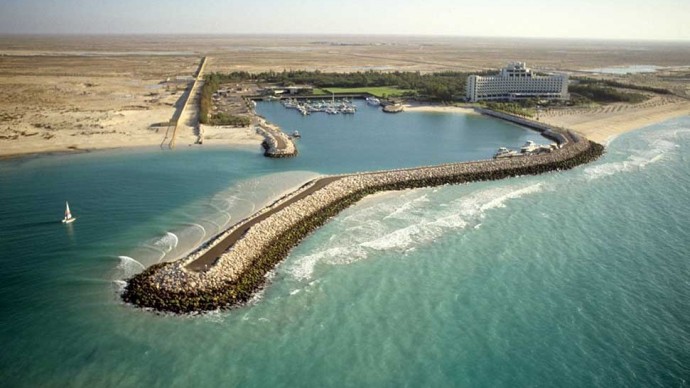 Because of the time it took to ready the helicopter, our pilot stayed at a hotel right next to the airport. When we arrived all we had to do is hop on, fasten our safety harnesses, put our headsets on and secure all our equipment. We removed all the doors to the helicopter in order to enable the three of us to shoot video and still photographs at the same time. No doors meant a lot of wind and anything left loose would usually end up falling into the “drink.”
Because of the time it took to ready the helicopter, our pilot stayed at a hotel right next to the airport. When we arrived all we had to do is hop on, fasten our safety harnesses, put our headsets on and secure all our equipment. We removed all the doors to the helicopter in order to enable the three of us to shoot video and still photographs at the same time. No doors meant a lot of wind and anything left loose would usually end up falling into the “drink.”
Most of the time, we had pretty good coordinates of where an attack had taken place or where a U.S. Navy-led convoy was passing. On a few occasions we even got lucky enough to witness an Iranian attack taking place. One time, the Iranian speedboats turned their guns on our helicopter as we approached the scene. After taking evasive measures, our pilot, a Vietnam veteran, reassured us that “hitting a helicopter with a rocket propelled grenade (RPG) from a speedboat, is about as difficult as hitting a bird in midflight with a BB gun.”
Each month, we were allocated 30 hours of flight time. Ideally, we tried to end each month under the allotted time so that we could take the helicopter up and “play” for a few hours. One of our favorite pastimes was “wadi bashing” or exploring the desert and mountains by helicopter. Another favorite end of month pursuit was flying down to the Jebel Ali Beach Resort for lunch by the pool. When we were out and about in the helicopter, there was never a problem being reachable in case of an emergency because all messages could be relayed via air traffic control. I doubt that it would be possible today to pass messages via traffic control with all the air traffic flying in and out of Emirate.
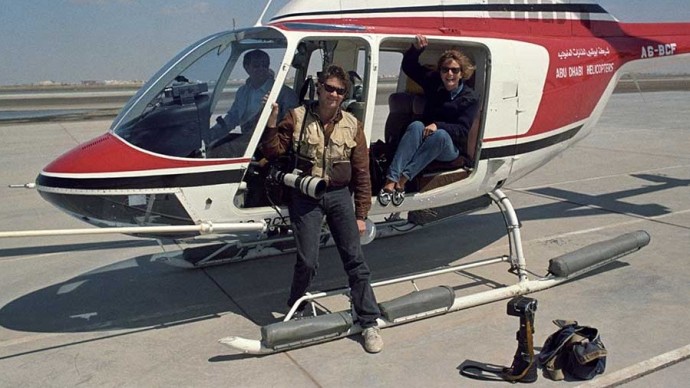 In the mid-1980s, Jebel Ali Resort was located about an hour drive south of Dubai. Once you left Dubai creek by road, there was pretty much nothing but desert until you reached the duty free port at Jebel Ali. Today Jebel Ali is just part of the greater Dubai metropolis.
In the mid-1980s, Jebel Ali Resort was located about an hour drive south of Dubai. Once you left Dubai creek by road, there was pretty much nothing but desert until you reached the duty free port at Jebel Ali. Today Jebel Ali is just part of the greater Dubai metropolis.
The CNN crew was usually quite gracious at the end of each month and would usually give up their seats and let my colleague and I do what we wanted with the helicopter. That would give us a chance to impress a few unsuspecting women by taking them to Jebel Ali resort for lunch in the chopper. What better way to impress a young lady!
In those days, it was not often that a hotel operator got a call from Dubai air traffic control requesting permission for a helicopter to land. Normally the only ones who flew around in helicopters were the police and military and neither of those made it a habit of landing at popular tourist resorts. For the unsuspecting hotel operator, a call from a helicopter meant only one thing, a visit by members of the royal family.
I can only imagine what the poor hotel manager thought after he got the message that a helicopter was approaching with the royal family on board.
It was quite amusing looking down at the hotel on our approach and seeing the hotel staff waiting patiently alongside the helipad. As soon as we touched down and stepped out of the helicopter we would be handed wet towels and offered a fruit cocktail before entering a car that would take us all of 20 meters to the hotel entrance.
I’m sure there was a unanimous sigh of relief when everyone realized that it was not the royal family but two raggedy photographers, their pilot and a couple of gorgeous ladies in tow.
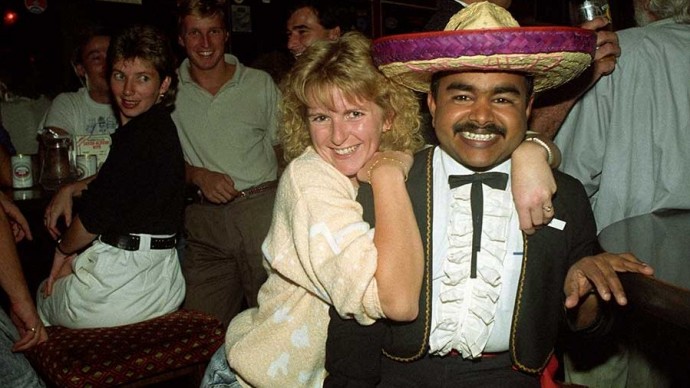 It was impossible to fly after sunset so we were free to do what we wanted every evening until the next morning. One of our favorite haunts was Pancho Villa, the first, and at the time only, Mexican restaurant in the entire Gulf region. It was operated by a Texan named Rudy who had years of training under his belt managing Tex-Mex restaurants in his home state. I had had Mexican food overseas before, namely in Europe and Egypt, but nothing compared to Pancho Villa in Dubai. It was authentic as one could get, right down to the little man wearing a sombrero at the door. Unbeknown to many of the clientele, the entire kitchen staff was from India. I remember once illustrating a story about the restaurant for my news agency and going back into the kitchen and seeing all the Indian cooks preparing curry and other Indian specialties. I was shocked to learn that none of the cooks actually liked the Mexican food they cooked.
It was impossible to fly after sunset so we were free to do what we wanted every evening until the next morning. One of our favorite haunts was Pancho Villa, the first, and at the time only, Mexican restaurant in the entire Gulf region. It was operated by a Texan named Rudy who had years of training under his belt managing Tex-Mex restaurants in his home state. I had had Mexican food overseas before, namely in Europe and Egypt, but nothing compared to Pancho Villa in Dubai. It was authentic as one could get, right down to the little man wearing a sombrero at the door. Unbeknown to many of the clientele, the entire kitchen staff was from India. I remember once illustrating a story about the restaurant for my news agency and going back into the kitchen and seeing all the Indian cooks preparing curry and other Indian specialties. I was shocked to learn that none of the cooks actually liked the Mexican food they cooked.
No matter where we went out for dinner, we would pretty much always show up at Pancho Villa for drinks and dancing later in the evening. Every night there was a live band that played the latest country western and pop hits.
Pancho Villa still exists but it was long ago superseded by dozens of other Mexican Restaurants.
Today, a brand “new” skyline overshadows much of what made Dubai so charming in the mid-1980s. Every time I return, I make it a point to visit my old haunts before they, too, all disappear. Recently, I went so far as to ask the receptionist at the Hyatt Galleria if I could see my old apartment, which was located on the 22nd floor. At the time, the Hyatt was one of the tallest hotels in the Gulf with an unprecedented view. As I stood there looking out of the window reminiscing about the past, I could not help but miss the Dubai of yesteryear.


